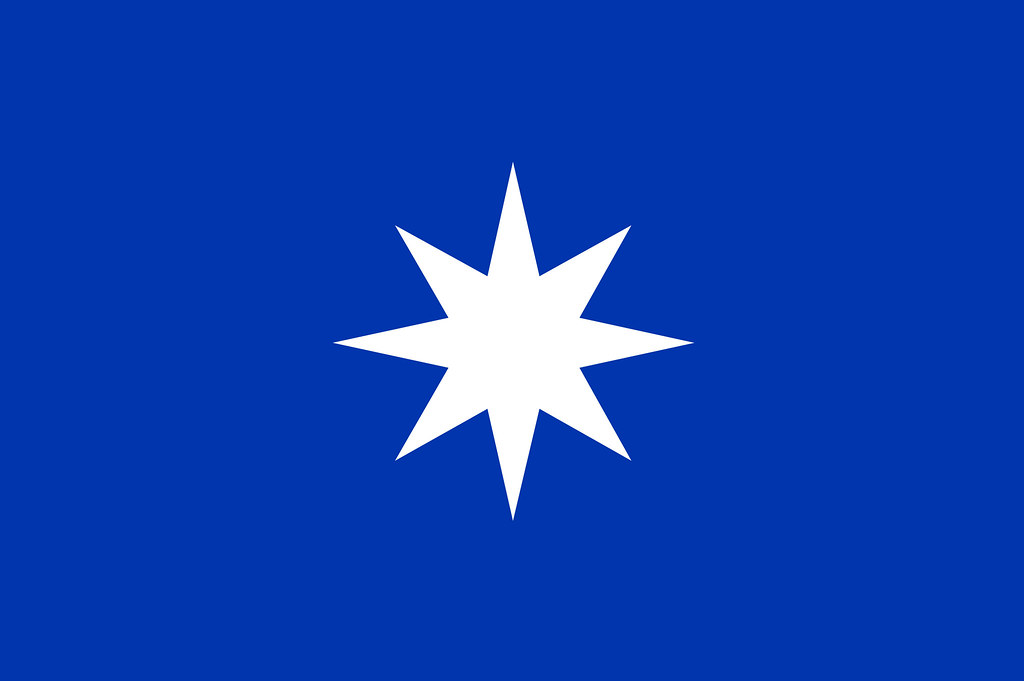Mapuche People
The Mapuche are an Indigenous people inhabiting south-central Chile and southwestern Argentina.
The name “Mapuche” means “People of the Land” in their language, Mapudungun.
They have maintained distinct cultural traditions, a strong social structure, and a proud history of resistance against Spanish colonization and later assimilation policies by the Chilean and Argentine governments.
Mapuche Flag and Symbols

Wüñellfe
Key Symbols
・A star/sun motif representing the universe; often appears on Mapuche flags and textiles.
Kultrún
・A sacred ceremonial drum, circular and decorated with a cross pattern, symbolizing the Mapuche worldview.
Language
・Name: Mapudungun
・Language Family:solate (not classified within any major language family)
・Speakers: Approximately 200,000 in Chile and Argentina (number declining)
・Grammar: Agglutinative (rich in suffixes and particles), basic word order SOV (Subject-Object-Verb)
Script
Writing System
・Traditionally, Mapudungun was an oral language. Today, the Latin alphabet (Spanish-style) is used for writing.
・No unique script exists, but standardized Latin-based orthography is increasingly used.
▶Mapudungun Example
omniglot.com

Common Mapudungun Greetings and Phrases
| English | Mapudungun | Pronunciation |
| Hello | Mari mari | MAH-ree MAH-ree |
|---|---|---|
| Good morning | Mari mari | MAH-ree MAH-ree |
| Thank you | Küme tüfa | KOO-meh TOO-fah |
| Nice to meet you | Kisu mapu | KEE-soo MAH-poo |
| Good night | Küme akuy | KOO-meh AH-kwee |
| Delicious | Küme | KOO-meh |
| Fun/Enjoyable | Ayüwn | AH-yoonn |
Note
Mari mari” is a universal greeting. “Küme” means “good” or “beautiful” and is used in various positive contexts.
Region
Continent: America
Region: South America Chile and Argentina
Access Guide
Mapuche Nation
The currency of the Mapuche people is the Chilean Peso (CLP).
Sample routes from major cities to Temuco (Chile, Mapuche homeland)
| Departure City | Direct/Transit | Arrival Airport | Flight Time (approx.) | Reference Fare (one-way/round-trip, Economy) |
| Los Angeles | LA→Santiago→Temuco | Temuco Airport (ZCO) | ~16–20 hrs | US$1,100–1,600 |
|---|---|---|---|---|
| New York | NY→Santiago→Temuco | Temuco Airport (ZCO) | ~16–21 hrs | US$1,200–1,800 |
| London | London→Europe→Santiago→Temuco | Temuco Airport (ZCO) | ~18–23 hrs | £900–1,300 |
| Tokyo | Tokyo→USA→Santiago→Temuco | Temuco Airport (ZCO) | ~28–32 hrs | ¥250,000–350,000 |
| Sydney | Sydney→Santiago→Temuco | Temuco Airport (ZCO) | ~15–18 hrs | A$1,700–2,200 |
| Hong Kong | HK→USA/EU→Santiago→Temuco | Temuco Airport (ZCO) | ~28–34 hrs | HK$10,000–16,000 |
| Shanghai | Shanghai→USA/EU→Santiago→Temuco | Temuco Airport (ZCO) | ~27–34 hrs | RMB 9,000–15,000 |
| Singapore | Singapore→USA/EU→Santiago→Temuco | Temuco Airport (ZCO) | ~29–35 hrs | S$2,000–2,800 |
Note: Fares and times are estimates; actual costs depend on season and route.
Language Origin
Language Origin & Historical Background
・Mapudungun is a language isolate, unrelated to other South American languages.
・Spoken for centuries on the west side of the Andes, it survived the Inca Empire and Spanish colonization.
・Speaker numbers are declining due to Spanish dominance, but revival movements are ongoing among the Mapuche people.
Traditional Games
For Children
Palín
A traditional stick-and-ball game similar to field hockey, played by teams. It is central to Mapuche cultural identity and enjoyed by all ages.
For Adults
Ngillatun
A religious ceremony rather than a game, but includes group competitions, races, and tests of strength during festivals.
Ayekauntun
Traditional dance and singing (Ayekauntun) are also key festival activities.
Introduction video


Summary
・The Mapuche are a proud Indigenous people of South America, deeply connected to their land and traditions.
・Main symbols include the “Wüñellfe” and “Kultrún.”
・The language Mapudungun is agglutinative and a language isolate.
・The traditional game Palín is a symbol of cultural pride.
